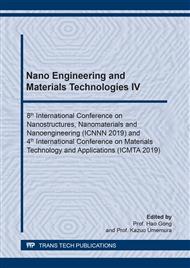p.220
p.225
p.231
p.239
p.244
p.250
p.256
p.262
p.267
Deformation and Fracture Mechanics of Superior Nanocomposites
Abstract:
Lightweight ultra-fine grained (<1 μm size) SiC-ZrO2(3Y2O3) composites, with a combination of high hardness, high bending strength and high fracture toughness, were successfully prepared by high energy mechanical milling followed by heat treatment. The SiC-ZrO2(3Y2O3) composites exhibitied high hardness (1707 MPa), high bending strengh (as high as 1689 MPa) and high fracture toughness (up to approximately 12.6 MPa.m1/2). Such a combination of mechanical properties was attributed to the fine microstructure with a distinct feature consisting of almost continuous network of ZrO2(3Y2O3) phase around SiC grains, or we call harmonic microstructure. It has been demonstrated that a combination of these unique microstructural characteristics was very effective in supressing the initiation of cracks and governing the path of their subsequent growth during fracture, leading to excellent combination of mechanical properties.
Info:
Periodical:
Pages:
244-249
Citation:
Online since:
May 2020
Authors:
Price:
Сopyright:
© 2020 Trans Tech Publications Ltd. All Rights Reserved
Share:
Citation:


